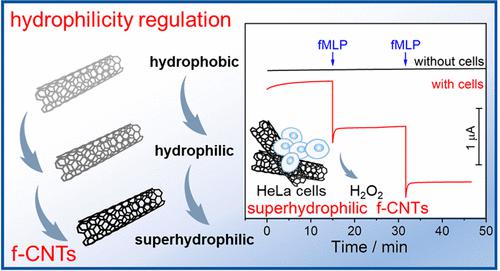当前位置:
X-MOL 学术
›
Anal. Chem.
›
论文详情
Our official English website, www.x-mol.net, welcomes your
feedback! (Note: you will need to create a separate account there.)
Superhydrophilicity Regulation of Carbon Nanotubes Boosting Electrochemical Biosensing for Real-time Monitoring of H2O2 Released from Living Cells
Analytical Chemistry ( IF 6.7 ) Pub Date : 2023-11-21 , DOI: 10.1021/acs.analchem.3c03981 Tuotuo Ma 1 , Jianqi Ye 1 , Yarui Tang 1 , Hongxing Yuan 1 , Dan Wen 1
Analytical Chemistry ( IF 6.7 ) Pub Date : 2023-11-21 , DOI: 10.1021/acs.analchem.3c03981 Tuotuo Ma 1 , Jianqi Ye 1 , Yarui Tang 1 , Hongxing Yuan 1 , Dan Wen 1
Affiliation

|
Dynamic and accurate monitoring of cell-released electroactive signaling biomolecules through electrochemical techniques has drawn significant research interest for clinical applications. Herein, the functionalized carbon nanotubes (f-CNTs) featuring with gradient surface wettability from hydrophobicity to hydrophilicity, and even to superhydrophilicity, were regulated by thermolysis of an ionic liquid for exploration of the dependence of surface wettability on electrochemical biosensing performance to a cell secretion model of hydrogen peroxide (H2O2). The superhydrophilic f-CNTs demonstrated boosting electrocatalytic reduction activity for H2O2. Additionally, the molecular dynamic (MD) simulations confirmed the more cumulative number density distribution of H2O2 molecules closer to the superhydrophilic surface (0.20 vs 0.37 nm), which would provide a faster diffusional channel compared with the hydrophobic surface. Thereafter, a superhydrophilic biosensing platform with a lower detectable limit reduced by 200 times (0.5 vs 100 μM) and a higher sensitivity over 56 times (0.112 vs 0.002 μA μM cm–2) than that of the hydrophobic one was achieved. Given its excellent cytocompatibility, the superhydrophilic f-CNTs was successfully applied to determine H2O2 released from HeLa cells which were maintained alive after a 30 min real-time monitoring test. The surface hydrophilicity regulation of electrode materials presents a facile approach for real-time monitoring of H2O2 released from living cells and would provide new insights for other electroactive signaling targets at the cellular level.
中文翻译:

碳纳米管的超亲水性调节促进电化学生物传感实时监测活细胞释放的 H2O2
通过电化学技术动态、准确地监测细胞释放的电活性信号生物分子引起了临床应用的重大研究兴趣。在此,通过离子液体的热分解来调节具有从疏水性到亲水性甚至超亲水性的梯度表面润湿性的功能化碳纳米管(f-CNT),以探索表面润湿性对电化学生物传感性能和细胞分泌的依赖性过氧化氢(H 2 O 2 )模型。超亲水性 f-CNT 表现出增强 H 2 O 2电催化还原活性。此外,分子动力学(MD)模拟证实,靠近超亲水表面(0.20 vs 0.37 nm)的H 2 O 2分子的累积数密度分布更多,与疏水表面相比,这将提供更快的扩散通道。此后,超亲水生物传感平台的检测下限比疏水生物传感平台降低了200倍(0.5 vs 100 μM),灵敏度提高了56倍以上(0.112 vs 0.002 μA μM cm –2 )。由于其优异的细胞相容性,超亲水性f-CNTs成功应用于测定HeLa细胞释放的H 2 O 2 ,该细胞在30分钟的实时监测测试后仍保持存活。电极材料的表面亲水性调节提供了一种实时监测活细胞释放的H 2 O 2的简便方法,并将为细胞水平上的其他电活性信号传导目标提供新的见解。
更新日期:2023-11-21
中文翻译:

碳纳米管的超亲水性调节促进电化学生物传感实时监测活细胞释放的 H2O2
通过电化学技术动态、准确地监测细胞释放的电活性信号生物分子引起了临床应用的重大研究兴趣。在此,通过离子液体的热分解来调节具有从疏水性到亲水性甚至超亲水性的梯度表面润湿性的功能化碳纳米管(f-CNT),以探索表面润湿性对电化学生物传感性能和细胞分泌的依赖性过氧化氢(H 2 O 2 )模型。超亲水性 f-CNT 表现出增强 H 2 O 2电催化还原活性。此外,分子动力学(MD)模拟证实,靠近超亲水表面(0.20 vs 0.37 nm)的H 2 O 2分子的累积数密度分布更多,与疏水表面相比,这将提供更快的扩散通道。此后,超亲水生物传感平台的检测下限比疏水生物传感平台降低了200倍(0.5 vs 100 μM),灵敏度提高了56倍以上(0.112 vs 0.002 μA μM cm –2 )。由于其优异的细胞相容性,超亲水性f-CNTs成功应用于测定HeLa细胞释放的H 2 O 2 ,该细胞在30分钟的实时监测测试后仍保持存活。电极材料的表面亲水性调节提供了一种实时监测活细胞释放的H 2 O 2的简便方法,并将为细胞水平上的其他电活性信号传导目标提供新的见解。















































 京公网安备 11010802027423号
京公网安备 11010802027423号